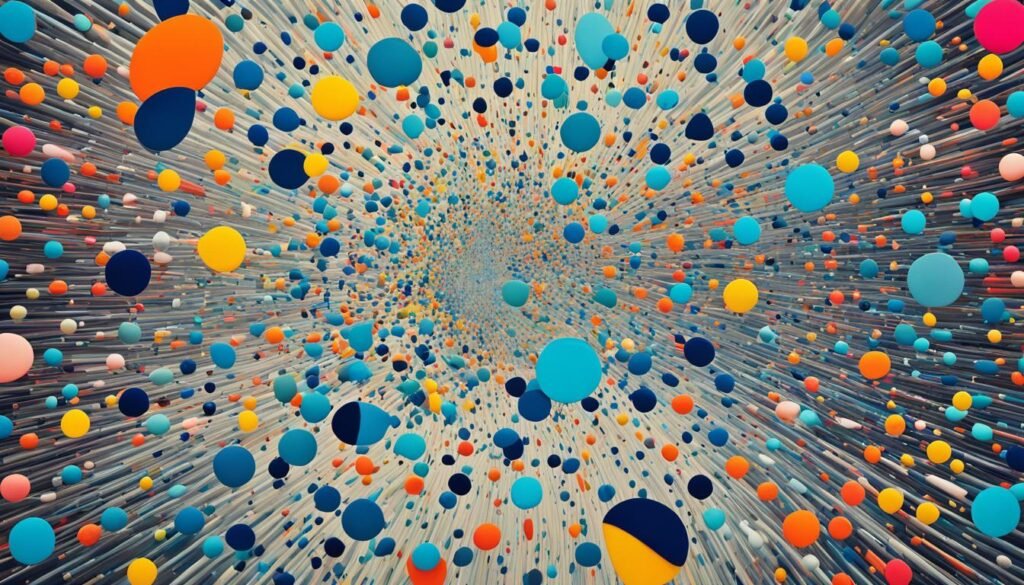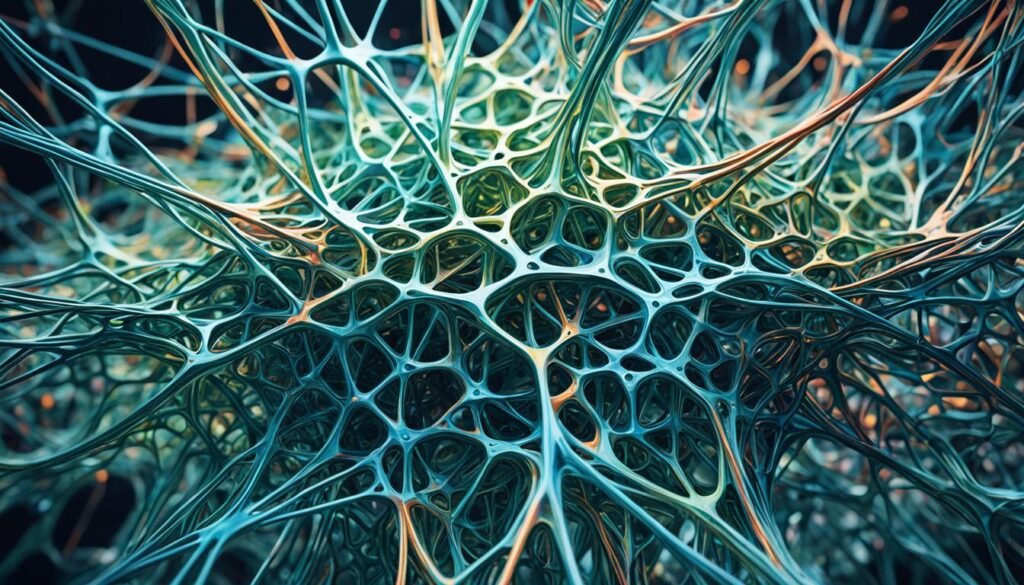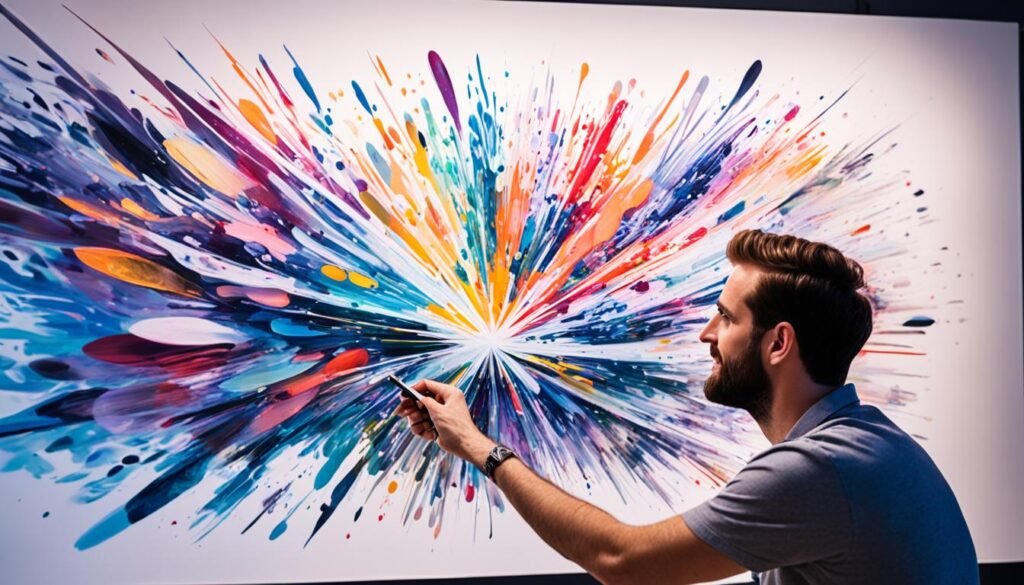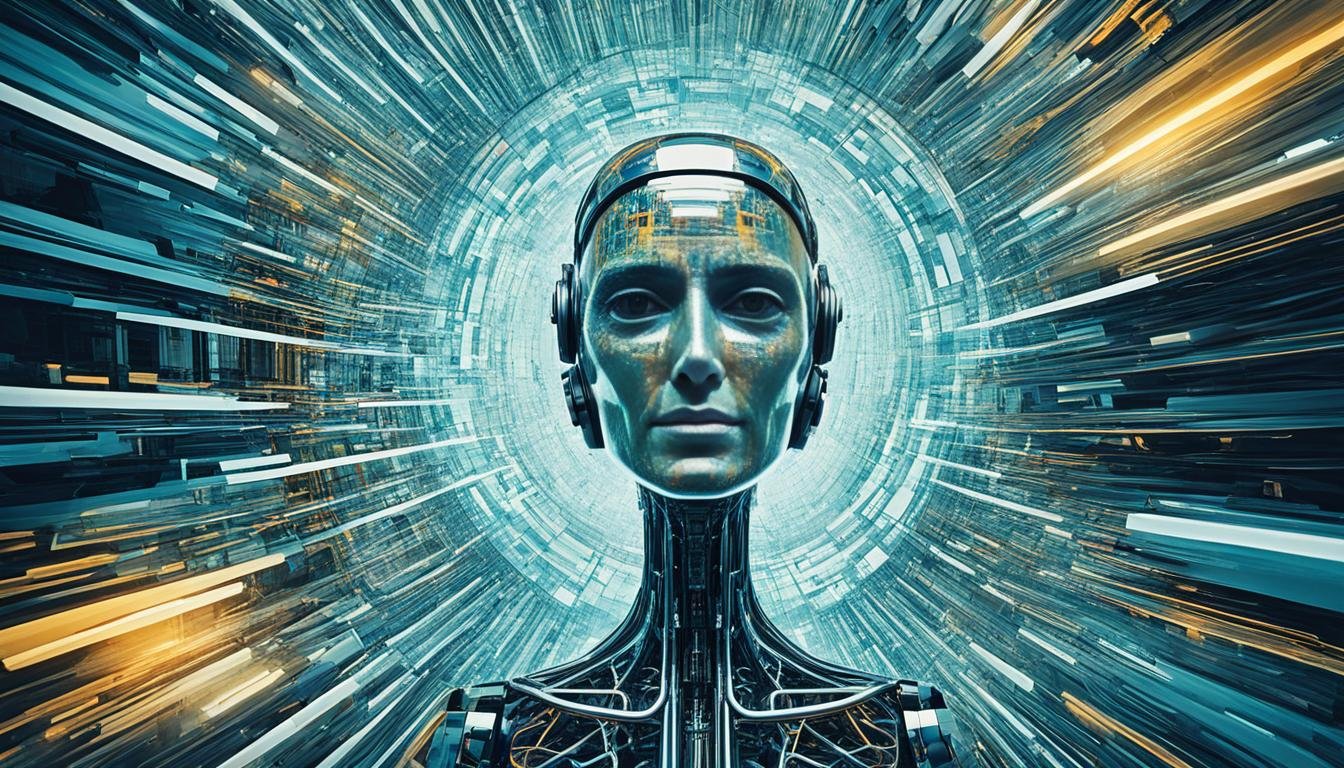In the 2010s, AI art made big strides, showing how neural networks could improve image patterns and open new creative doors. The start of Generative Adversarial Networks (GANs) in 2014 let AI make new images from learned data. This was a big step forward, as it didn’t need to start with existing art.
Since then, a GAN-made artwork, “Portrait de Edmond de Belamy,” was sold at Christie’s for over $400,000. This showed the art world was ready for AI creativity.
Now, AI tools are becoming more important in the art world. They help by analyzing data to spot new trends and making art from text prompts. This mix of human and machine creativity is changing how we think about art.
Also, AI art tools are getting cheaper and more accessible. This lets more artists try their hand at it, even without formal training. It’s opening up new areas for digital creativity.
Key Takeaways
- AI-generated art has made big strides, showing the power of neural networks in creative tasks.
- Generative Adversarial Networks (GANs) let AI make new images from data, without using old art.
- AI tools are used in art to analyze data, spot trends, and help with curating art.
- AI art tools are getting cheaper and more accessible, letting more artists join without formal training.
- The mix of human and machine creativity is changing the art world, opening new doors for digital art.
The Rise of AI in the Art World
The art world has seen a big change thanks to AI technology’s fast growth. AI-generated art is now a big topic, making people think about what creativity and art mean.
Defining AI-Generated Art
AI-generated art means art made with a lot of help from artificial intelligence. Complex algorithms like neural networks and machine learning make AI systems that can make art. These systems learn from lots of art from different times and styles. They use this knowledge to make new and creative art.
The Rapid Evolution of AI in Art
AI’s growth in art has been amazing. AI art is getting harder to tell apart from art made by humans. This change is making art more creative and challenging old ideas about making art. The impact of AI on art is clear, changing how we make, see, and value art.
| Metric | Impact of AI on Art |
|---|---|
| Art Research and Cataloging | AI has made these tasks much faster, cutting down research time from days to seconds. |
| Market Analysis | AI helps art experts understand market trends, track famous people, and analyze buying habits very quickly. |
| Artwork Identification | Companies like Art Recognition use AI to identify unknown paintings with 96% accuracy, which can change art prices by hundreds of millions. |
AI’s rise in art brings both good and bad things. It can make some people feel left out if they don’t have access to AI. Also, not having enough data on art sales can make it hard to predict the market.
“AI can serve as an indicator in the art market, but it may not accurately predict auction prices due to market fluctuations and the lack of comprehensive data.”
– Tech entrepreneur Boris Pevzner
But, the future of AI in art looks bright. It’s seen as a way to improve art, not a threat. As AI and art keep evolving, artists, collectors, and the art world will need to figure out how to use this new technology well.

How AI Art Works: Decoding the Process
The world of machine learning art and neural networks art is fascinating. AI systems learn from huge amounts of artwork. They use machine learning and deep learning to spot patterns and styles. This knowledge helps them make new, unique art.
From Data to Artistic Masterpieces
Turning data to art is a complex task. AI systems analyze and mix the patterns and styles they’ve learned. This leads to art that is both unique and stunning, expanding creativity.
- Some AI programs use “style transfer,” blending styles to create something new.
- Other AI systems can make art that’s completely new, without copying any style, showing their creative power.
The growth of neural networks art and machine learning art is changing the art world. It’s making us rethink what creativity and authorship mean. As we explore ai art creation, the ways humans and AI can work together in art are growing. This is starting a new era of digital creativity.

AI as a Creative Partner
AI can be a great help for artists, not a replacement for their creativity. By working with AI, artists can try out new styles and techniques. This lets them see things they might not have thought of before. AI can do the hard or boring tasks, so artists can focus on the fun and emotional parts of making art.
AI can spark new ideas, create patterns, and suggest new paths. This helps artists share their unique vision and stories. Working together, humans and machines make art that’s better than the sum of its parts.
Enhancing Human Creativity
AI can help visual artists by making abstract patterns, changing images, or starting new projects. DeepDream, an AI tool by Google, can make surreal and abstract images by tweaking existing ones. It’s great for artists looking for unique visuals. AI can also make music, looking at old songs to come up with new tunes.
It’s tricky to find the right balance between using AI and staying true to your art. Artists need to keep their own style, not rely too much on AI, and keep developing their skills. They also need to hold onto their artistic instincts when using AI.

“AI can be a powerful tool for enhancing human creativity, but it’s essential for artists to maintain their unique vision and artistic identity.”
By seeing AI as a partner, artists can explore new ideas and take their art to new heights. This leads to making innovative and thought-provoking art.
The Spectrum of AI Art
AI-generated art covers a wide range, showing how versatile this tech is in art. At one end, artists use AI to boost their creativity. They start with AI ideas or let them spark new work. At the other end, AI makes art on its own, with little to no human help.
This range shows how artists work with AI to grow their creativity. As spectrum of ai art grows, we see more degrees of ai involvement in art. This makes the line between human and machine-made art fade.
| AI Involvement in Art | Examples |
|---|---|
| Highly Human-Driven |
|
| Highly AI-Driven |
|
The spectrum of ai art and degrees of ai involvement in art show how humans and machines are working together in art. As AI gets better, we must think about the ethical and practical sides. We need to make sure AI is used right in the art world.
“AI art is reshaping the artistic paradigm and attracting significant attention, which is seen as essential for the success of contemporary institutions.”
Navigating the Challenges of AI Art
The art world is changing fast with AI, facing big challenges that could change how art is made and owned. One big worry is about copyright and ownership of AI art.
AI art is pushing the limits of creativity, mixing human and machine work. This has started a debate on who owns these new digital artworks. Copyright laws need to change to understand AI’s role in making art. This way, both artists and AI systems get the credit they deserve.
Preserving Artistic Identity
Using AI in art also worries about losing the artistic identity. As AI art grows, there’s fear that the deep feelings and personal stories in human art could be lost.
Artists work hard to make their art unique with their own views and style. The worry is that AI art could make these skills and true art feel less valuable.
For these issues, transparency in AI art creation is key. Showing how AI art is made and its originality helps build trust. This way, the human touch in art stays important as we use this new tech.

“The blending of human and machine creation blurs the lines in AI art, raising complex questions about ownership, authenticity, and the very definition of what it means to be an artist.”
The art world is figuring out how to handle AI art. It’s important to find a balance between new tech and keeping art’s true spirit. By tackling copyright, ownership, and authenticity, the art world can make AI art better, not worse.
Embracing AI: New Frontiers for Artists
AI is changing the art world in exciting ways. It combines human creativity with technology. This lets artists try new styles and ideas they might not have thought of before.
Expanding Creative Possibilities
AI helps artists by automating simple tasks. This lets them focus more on the creative part of their work. Recent advances in AI have made artworks almost indistinguishable from human-made art, opening new doors for art and collaboration between humans and machines.
AI-Assisted Design and Generative Art
Generative art is changing how artists work. It uses AI to create unique pieces. Artists mix their style with AI’s surprises to make something new.
AI art uses algorithms to make visuals from many images of art, making each piece unique. This leads to interesting and new results.
“AI offers new tools and methods to artists, such as photography, digital editing, inkjet printing, and 3D printing, expanding the realm of artistic expression.”
As artists use AI more, they can dream bigger and explore new ways to express themselves. This is changing modern art and inspiring new artists.
| AI Art Creation Mechanisms | AI-Enhanced Business Management | Artistic Collaboration and Networking with AI |
|---|---|---|
|
|
|
how ai art works
AI has changed the art world, mixing human and machine creativity. AI-generated art uses complex algorithms like neural networks and machine learning. These algorithms help AI systems study and learn from lots of art.
Then, AI can make new art that looks like it was made by humans. It does this by spotting patterns, making new designs, and mixing different art styles. This makes the art unique.
In 2022, we saw new AI art tools like DALL-E 2, Midjourney, Craiyon, and Stable Diffusion. OpenAI made DALL-E 2 available to everyone on September 28th. DALL-E and Midjourney let users try out AI-generated art for free. Midjourney uses Discord, a popular online spot, and DALL-E is known for its realistic and simple AI art.
AI can be a big help for artists, but it also brings challenges. These include keeping an artist’s identity, dealing with copyright issues, and keeping the emotional depth of traditional art. As art changes, AI and art together open new ways to explore and express creativity.
“The integration of AI in the art world has transformed the creative process, blurring the lines between human and machine creativity.”
The Future of Art: A Human-AI Collaboration
The future of art is about working together between humans and AI. AI is becoming more important in making art. We need to think about the ethical considerations of AI art. We must make sure technology helps humanity, not just itself. We should follow human-centered design rules like being open, including everyone, and respecting privacy.
By focusing on ethics and human values, artists and tech experts can use AI’s power for good. This way, AI won’t harm us but will make our lives better. As art changes, combining human and machine will change creativity. It will open new ways to express art and push the limits of digital art.
Ethical Considerations and Human-Centered Design
Using AI in art brings up big ethical considerations of AI art. For example, Google’s project lets people see high-resolution art with AI in VR and AR. But, it makes us think about who owns art and how it stays true to the artist’s vision.
- The European Commission’s High-Level Expert Group on AI looks into the rights and duties of artists with AI.
- AI can look at what we like and suggest art we might enjoy, which makes us wonder about our privacy.
- New tech like GANs and neural style transfer lets artists try new styles. But, it also makes us question what makes art truly ours.
By following human-centered design, the art world can deal with these tough issues. This way, art’s future will be shaped by both humans and machines. We’ll keep the heart of human creativity alive.
“The collaboration between humans and AI in art is not about replacing artists but enhancing their creative process.”
As the future of art and ai comes to life, artists, scholars, and art groups are talking about how AI and human creativity can work together. They aim for amazing art that shows what we can do when humans and AI work together. This partnership will open new doors in art and change what being an artist means in our digital world.
Conclusion
The mix of art and artificial intelligence is changing how we create, collaborate, and innovate. By using AI as a tool, artists are pushing the limits of what art can be. They’re exploring new ways to make art and enhance human creativity.
AI has changed the art world in many ways. It has brought new forms of art like generative art and AI-assisted design. These changes are making us rethink what art means, who makes it, and why we make it. As technology and art continue to blend, the future of art looks bright and full of possibilities.
The art world is entering a new era with the fusion of art and AI. This mix is reshaping creativity and how we express ourselves. The impact of AI on art is clear, and the future of art and AI looks exciting. It’s a future where human and machine creativity come together, opening new doors for artistic innovation.
FAQ
How does AI generate art?
AI creates art by using complex algorithms like neural networks and machine learning. These systems analyze and learn from huge amounts of art. Then, they use this knowledge to make new art that looks like it was made by humans.
What is the difference between AI-generated art and human-created art?
The main difference is how it’s made. AI art comes from algorithms and learning machines. Human art comes from an artist’s own vision and skills. But, AI art is getting better and harder to tell apart from human art.
How can AI be used as a creative tool for artists?
AI can be a great help for artists. It lets them try out new styles and ideas. AI can do the hard tasks, so artists can focus on the creative parts. It can also inspire them, create patterns, and suggest new ideas, helping them tell their stories.
What are the challenges of integrating AI in the art world?
Some big challenges include copyright issues and the worry that AI might make human art less valuable. Artists need to keep their unique touch and vision. They must make sure their art stays true to them, even with AI’s help.
How is the future of art shaped by the collaboration between human creativity and artificial intelligence?
The future of art will be about working together with AI. By focusing on ethics and human values, we can use AI to improve art. This mix of human and machine will open new ways to express creativity and push art into the digital future.
